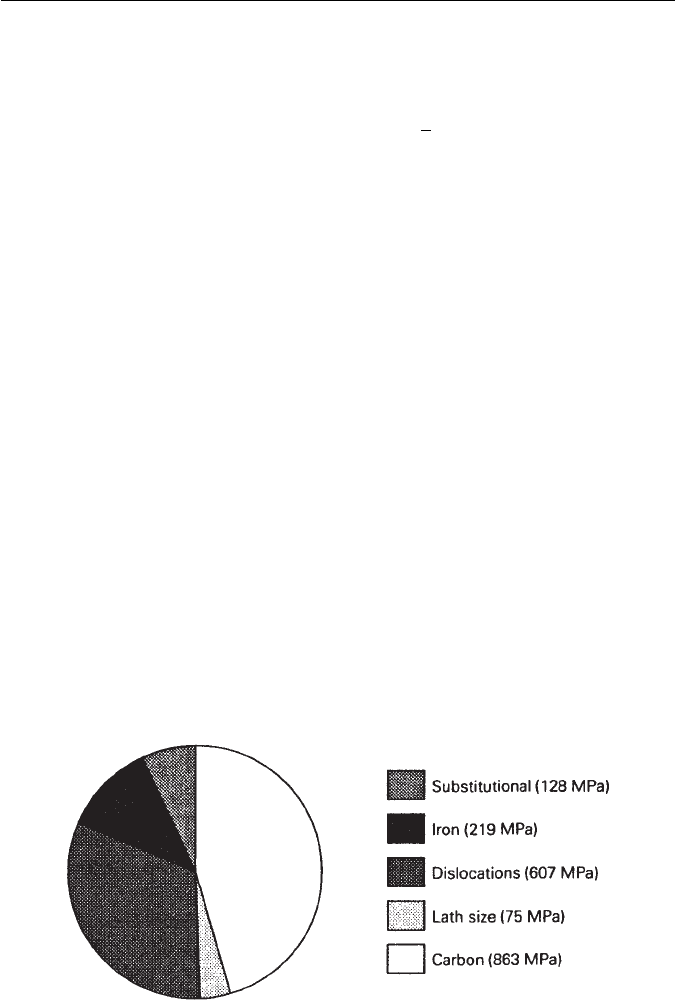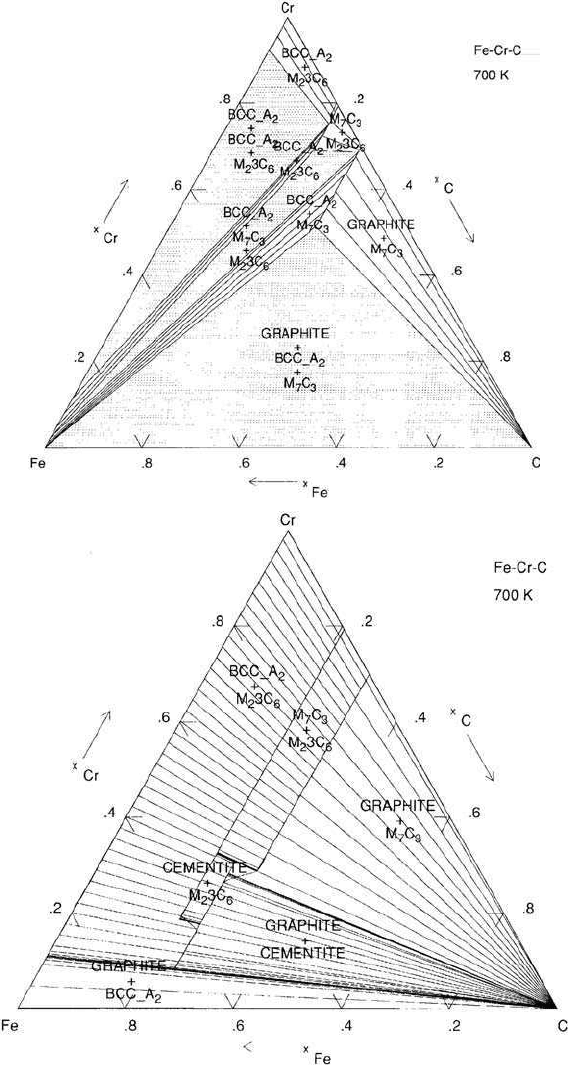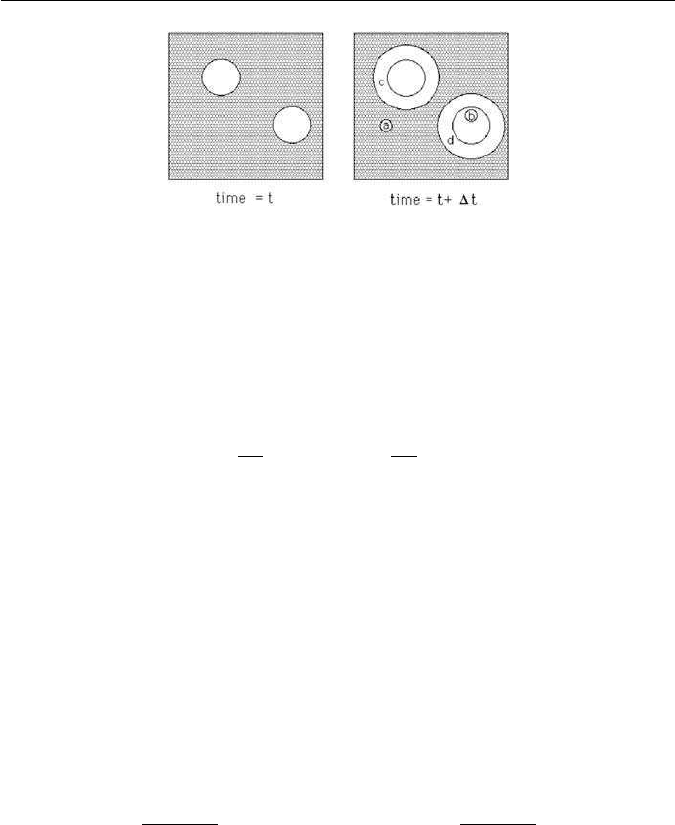Bhadeshia H.K.D.H., Honeycombe R. Steels: Microstructure and Properties
Подождите немного. Документ загружается.


318 CHAPTER 14 MODELLING OF MICROSTRUCTURE AND PROPERTIES
x
γ
is theconcentration in theresidual austenite before it transforms into marten-
site, so that its value is important in determining the hardness of the martensite.
Solid-solution theory indicates that the strength increment due to dissolved
carbon should vary with the square root of the carbon concentration:
σ
SS
C
= 1722.5 × x
1/2
, (14.13)
where strength is in MN m
−2
and the concentration x is expressed in wt%.
14.3.4 Dislocations
When martensite or bainite form at high temperatures, the shape change due to
shear transformation causes plastic deformation, and hence the accumulation
of dislocations in both the parent and product phases (Chapter 6). The extent
of the plasticity depends on the yield strength, and hence on the temperature.
Takahashi and Bhadeshia have therefore suggested that the dislocation density
(ρ
D
) of both martensite and bainite can be represented empirically as a function
of temperature alone, for the temperature range 570–920 K:
log
10
{ρ
D
}=9.2840 +
6880.73
T
−
1780360
T
2
, (14.14)
where T is the transformation temperature in Kelvin, and ρ
D
is stated in units
of m
−2
. The strengthening σ
ρ
(MN m
−2
) due to dislocations is given by:
σ
ρ
= 0.38 µb(ρ
D
)
0.5
≃ 7.34 × 10
−6
(ρ
D
)
0.5
, (14.15)
where µ is the shear modulus and b is the magnitude of the Burgers vector.
14.3.5 Lath size
Martensite and bainite grow in the form of very fine plates or laths. The resulting
grain size strengthening σ
G
is defined as:
σ
G
≃ 115(
L)
−1
MN m
−2
, (14.16)
where
L (µm) is the mean linear intercept measured on random sections. This
is not the classical Hall–Petch relation (Chapter 2) but another relation due to
Langford and Cohen, because at the typically sub-micrometre grain sizes, the
mechanism of yield is different, involving the initiation of dislocation sources
in the grain boundaries.
14.3.6 Martensite composition and transformation temperature
The excess carbon in the bainitic ferrite partitions into the residual austenite,
whichthen transforms tomartensite.The carbon concentrationofthe martensite

14.3 EXAMPLE 2: MECHANICAL PROPERTIES OF MIXED MICROSTRUCTURES 319
can therefore be calculated from a simple mass balance (Equation (14.11)). The
martensite-start temperature (Chapter 4, M
S
) of the residual austenite can be
written:
M
S
= M
0
S
− 564(x
γ
−
x), (14.17)
where the concentrations are in wt%, the temperatures in centigrade and M
0
S
is
the martensite-start temperature of austenite with the average composition of
the alloy.
The different contributions to the strength of martensite are illustrated in
Fig. 14.7. Carbon is a major contributor since it causes a severe, asymmetrical
distortion of the martensite crystal structure and hence interacts strongly with
the movement of dislocations. The dislocation density itself makes a significant
contribution to the overall strength.
14.3.7 Strength of mixed microstructures
The normal way to calculate the strength of a multiphase alloy is to use a rule of
mixtures, i.e. to calculate a mean strength from the strength of each component
phase weighted by its volume fraction. However, this is not adequate for the
present purposes because of constraint effects. It is well established in fracture
mechanics that the yield strength is increased by plastic constraint. This is why
a weak brazing alloy can be used to effectively bond much stronger samples, as
long as the thickness of the braze material is small enough to be constrained
throughout by the surrounding stronger matrix. Indeed, the strength of the joint
increases as the thickness of the braze layer decreases.
Dispersions of bainite plates form in austenite which subsequently trans-
forms to much stronger martensite.Young,therefore,assumed that deformation
Fig. 14.7 Calculated components of the room-temperature strength of virgin martensite in
Fe–0.4C–0.2Si–0.71Mn–1.9Ni–0.25Mo–0.88Cr wt% alloy. This is a typical ultra-high-strength
steel of the type used in the manufacture of gears, gun barrels, etc.

320 CHAPTER 14 MODELLING OF MICROSTRUCTURE AND PROPERTIES
Fig. 14.8 Plot of the normalized strength of a brazed joint versus the normalized thickness
of the brazing material, the latter being identified with the fraction of bainite in a martensitic
matrix (Young and Bhadeshia, Materials Science and Technology 10, 209, 1994).
of the bainitic ferrite is constrained by the harder martensite in the same way as
the braze material is constrained by the surrounding matrix. The constraint can,
therefore, be modelled using experimental data available from brazed joints
in high-strength steels. The brazing alloys used in making the joints were non-
ferrous materials which are ordinarily rather weak. The data, in a normalized
form, are summarized in Fig. 14.8. The vertical axis is the joint strength nor-
malized with respect to that of the unconstrained braze material; the horizontal
axis is the braze thickness normalized relative to a thickness value where the
restraint effect vanishes.
To analyse the properties of a mixed microstructure, it can be assumed that
the normalized braze thickness is equivalent to the volume fraction of bainite.
Using this assumption, and the form of the normalized strength versus nor-
malized thickness plot (Fig. 14.8), the strength of constrained bainite may be
represented by the equation:
σ ≃ σ
0
[0.65 exp{−3.3V
b
}+0.98] ≤ σ
M
, (14.18)
whereσ and σ
0
representthe strengthsof constrainedand unconstrained bainite,
respectively, σ
M
is the strength of the martensite and V
b
is the volume fraction
of the bainite. The strength of bainite is always less than or equal to that of
martensite.

14.4 METHODS 321
Fig. 14.9 The strength contributions of bainite and martensite in the mixed microstructure.
When the volume fraction V
b
of bainite is small, its strength nearly matches
that of martensite (Fig. 14.9), always remaining above that of bainite on its
own. The strength of martensite continues to increase with the fraction of bai-
nite, as the carbon concentration of the residual austenite from which it grows,
increases.
Figure 14.10 showshowthe strength ofthe mixedmicrostructureis predicted.
Line (a) on Fig. 14.10 shows that a rule of mixtures cannot account properly
for the variations observed. The agreement between calculation and experi-
ment improves (curve b) as allowance is made for the change in the strength
of martensite as carbon partitions into the austenite, due to the formation of
bainite. The consistency between experiment and theory becomes excellent as
constraint effects are also included in the calculations (curve c).
14.4 METHODS
The two examples described in the preceding sections are necessarily simpli-
fied presentations of quite complex models. It is useful to illustrate some of
methods that are now common in the mathematical modelling of steels. It is
worth emphasizing that in general it is a combination of methods that leads
to useful solutions, with the optimum approach to a problem being one that is
interdisciplinary.

322 CHAPTER 14 MODELLING OF MICROSTRUCTURE AND PROPERTIES
Fig. 14.10 Comparison of calculations against experimental data due to Tomita and
Okabayashi.
14.4.1 Electron theory
A metal is created when atoms are brought so close together, that the electro-
static repulsion in transferring a valency electron between the adjacent atoms
is offset by the gain due to the delocalization of electrons. This enables the
valencyelectrons to movewithin themetal.The delocalizedelectrons feela weak
electrostatic field from the positively charged cores of atoms because of repul-
sion by the core electrons. The valence electrons are also screened from each
other by positive holes which surround them. All this makes it possible to intro-
duceapproximations which allowa single-electronwave functionto beexploited
in calculating the energy of an electron gas in a metal.
These electrons are able to move, without being scattered by the partly
screened potential of the positive ion cores because the latter provide a periodic
potential whose effect is simply to modulate the free-electron wave function.
Difficulties only arise when the electrons satisfy the Bragg condition within the
metal. This introduces band gaps in the distribution of electron energies. The
metallic state can only exist if the valency bands are partly filled.
Usingthese concepts,theenergy oftheelectron gascanbe expressedin terms
of the potential due to the ion cores, Coulomb interactions, kinetic energy and
exchange and correlation effects. It is then possible to calculate with an input
of the electronic charge and the atomic number of the element, properties such
as the cohesive energy of crystals, the elastic moduli, magnetic and acoustic
properties. The calculations are limited to small numbers of atoms because they
are extremely computer intensive. Figure 14.11 shows some calculations of the

14.4 METHODS 323
Fig. 14.11 The cohesive energy at 0 K versus the volume per atom divided by the volume of
an iron atom, for two crystal structures of iron. Data from Paxton, A. T., Methfessesl, M. and
Polatoglou, H. M., Physical Review B 41, 8127, 1990.
cohesive energy of two allotropic forms of iron, austenite (face-centred cubic
(fcc)) and diamond cubic. In each case the cohesive energy goes through a
minimum, which gives the expected density of the allotrope. The calculation
of the diamond form of iron shows how it is possible, using electron theory,
to estimate the properties of phases which do no exist in reality. Such a form
would have a density of only 5 g cm
−3
, but unfortunately, the energy difference
relative to the stable forms of iron is simply too large, meaning that it would be
improbable for the fcc→diamond transition to be induced, e.g. by alloying.
14.4.2 Phase diagram calculations and thermodynamics
Given experimentally determined thermodynamic data, it is possible to esti-
mate in multi-component, multiphase alloys, the stable phases, their equilibrium
fractions and equilibrium chemical compositions as a function of temperature,
pressure, magnetic fields and the detailed composition of the alloy. In other
words, all the information plotted on phase diagrams.
The free energy of a phase α is simply the weighted mean of the free energies
of its component atoms (µ
i
) which for a binary solution containing components
A and B is:
G
α
= (1 − x)µ
α
A
+ xµ
α
B
,
where x is the mole fraction of B. µ
α
i
is also known as the chemical potential
of component i in phase α. Although this equation is expressed for a binary
solution, it is generally true that equilibrium between any number of phases in
contact, containing any number of components, is defined by:
µ
α
i
=µ
β
i
= ... for i = 1, 2, 3, ... and phase = α, β...
The chemical potential must be uniform everywhere at equilibrium.

324 CHAPTER 14 MODELLING OF MICROSTRUCTURE AND PROPERTIES
There are many thermodynamic methods which express the chemical poten-
tial as a function of the mixing of solutes in a phase. Most of these methods are
either too simple or so complex that they cannot easily be generalized. There-
fore, in the computer calculations, the deviation of the free energy of mixing
from that of an ideal solution,
1
i.e. the excess Gibbs free energy, is written as an
empirical polynomial equation:
e
G
AB
= x
A
x
B
i
L
AB, i
(x
A
− x
B
)
i
,
where L
i
are measured interaction coefficients, in this case for a binary solution.
For a ternary solution:
e
G
ABC
=x
A
x
B
i
L
AB, i
(x
A
− x
B
)
i
,
+ x
B
x
C
i
L
BC,i
(x
B
− x
C
)
i
,
+ x
C
x
A
i
L
CA, i
(x
C
− x
A
)
i
.
The advantage of this kind of a polynomial becomes clear, since the relation
reduces to the binary problem when one of the components is set to be identical
to another, e.g. B ≡C. The method can be extended to deal with any number of
components, with the great advantage that few coefficients have to be changed
when the data due to one component are improved. It is therefore adopted in
many of the phase diagram calculation programs available commercially.
Although thermodynamics is usually associated with the state of equilib-
rium,the calculation method can also be used to estimate constrained equilibria,
e.g. para-equilibrium (Chapter 3) and diffusionless transformation (Chapter 5).
Figure 14.12 illustrates calculated isothermal Fe–Cr–C phase diagrams for both
the equilibrium and para-equilibrium states – notice the dramatic change when
substitutional solutes are not allowed to partition between the phases.
There is another subtle application of thermodynamics in the design of steels,
dealing with steady-state processes in which the system is not at equilibrium
but an appropriate observer may not perceive change. An example is diffusion
across a constant gradient; neither the flux nor the concentration at any point
changes with time, and yet the free energy of the system is decreasing since
diffusion occurs to minimize free energy. The rate at which energy is dissipated
is the product of the temperature and the rate of entropy production (i.e. Tσ):
Tσ = JX,
1
An ideal solution is one in which the atoms mix at random at all temperatures.

Fig. 14.12 Isothermal section of the Fe–Cr–C system.The body-centred cubic phase is ferrite
and M stands for a mixture of iron and chromium atoms in a variety of carbide phases (courtesy
of J. Robson).

326 CHAPTER 14 MODELLING OF MICROSTRUCTURE AND PROPERTIES
where J is a generalized flux of some kind, and X a generalized force. In the
case of an electrical current, the heat dissipation is the product of the current (J)
and the electromotive force (X). Provided that flux-force sets can be expressed
as in this way, it is found that J ∝X for small deviations from equilibrium. In
the case of the electrical current, this leads to Ohm’s law where the current is
proportional to the electromotive force.
This concept can be applied to the case where a number of irreversible pro-
cesses occur simultaneously. In a ternary Fe–Mn–C alloy, the diffusion flux
of carbon depends not only on the gradient of carbon, but also on that of
manganese. Thus, a uniform distribution of carbon will tend to become inhomo-
geneous in the presence of a manganese concentration gradient. When there is
more than one dissipative process, the total energy dissipation rate is the sum
of all the dissipations:
Tσ =
i
J
i
X
i
,
with
J
i
= M
ij
X
j
with i, j = 1, 2, 3 ...
and it is the cross coefficients M
ij
i =j that drive the diffusion of carbon in a
gradient of manganese. The theory is widely applied in computer calculations
of the kinetics of phase transformations in steels.
14.5 KINETICS
Almost all the solid-state transformations in steels involve nucleation and
growth. The theories for these two processes are well established and have been
described in previous chapters.The evolutionof thevolume fractionrequires the
additional treatment of impingement between particles which nucleate at dif-
ferent locations. This can be done using the powerful extended volume concept
of Kolmogorov, Johnson, Mehl and Avrami.
Consider the two particles illustrated in Fig. 14.13 for time t; a small interval
δt later, new regions marked a, b, c and d are formed assuming that they are
able to grow unhindered whether or not the region into which they grow is
already transformed. However, only those components of a, b, c and d which
lie in previously untransformed matrix can contribute to a change in the real
volume of the product phase (α):
dV
α
=
1 −
V
α
V
dV
α
e
,
where it is assumed that the microstructure develops at random. The subscript
e refers to extended volume, V
α
is the volume of α and V is the total vol-
ume. Multiplying the change in extended volume by the probability of finding

14.5 KINETICS 327
Fig. 14.13 The concept of extended volume. Two precipitate particles have nucleated together
and grown to a finite size in the time t. New regions c and d are formed as the original particles
grow, but a and b are new particles, of which b has formed in a region which is already
transformed.
untransformed regions has the effect of excluding regions such as b, which
clearly cannot contribute to the real change in volume of the product. For a
random distribution of precipitated particles, integration gives the real volume
fraction:
V
α
V
= 1 − exp
−
V
α
e
V
.
The extended volume V
α
e
is straightforward to calculate using nucleation and
growth models and neglecting any impingement effects. Solutions typically take
the form:
ξ = 1 − exp{−k
A
t
n
},
which can be compared with, e.g. Equation (3.9) for the progress of the pearlite
reaction.
The idea can be extended to the case where more than one reaction occurs
at the same time, as is frequently the case with precipitation reactions during
the tempering of martensite. Suppose α and β precipitate simultaneously, then
the relation between extended and real space becomes a coupled set of two
equations:
dV
α
=
1 −
V
α
+ V
β
V
dV
α
e
and dV
β
=
1 −
V
α
+ V
β
V
dV
β
e
, (14.1)
which in general must be solved numerically.
There has in recent years been much prominence given to the phase field
method as an alternative technique for calculating the evolution of microstruc-
ture. This begins with the description of the entire microstructure in terms of an
order parameter. The precipitate and matrix each have a particular value of the
orderparameter andthe interfacebetween these islocated by thepositionwhere
the order parameter changes from its precipitate-value to its matrix-value. The
range over which it changes is the width of the interface. The set of values of the
order parameter over the whole microstructure is the phase field.
